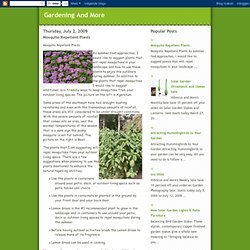

Fall Vegetable Gardening 101. 50 Ways to Fertilize the Garden For Free. My resident gardening expert is my friend Maria.

She’s been gardening for YEARS, and is full of awesome advice on all sorts of issues. She’s the one that helped me get rid of the grey flesh fruit flies that nearly decimated my tomatoes. Blog Archive Waxing Cheese. Several weeks ago I had a chance to experiment with waxing cheese.

I really had no idea what I was doing, but I’ll show you how it went anyways. Just for fun. And it was fun. Probably too much fun. Strategies For Grafting Fruit Trees. You’re looking at scions set in the split stump of a small branch that conveniently sprouted two seasons ago.

This graft points into a space that could really use a low branch. Notice the leaf buds where the scions meet the stump. The most rapid growth occurs around leaf buds, so the design of the graft encourages the scion to grow into the stump. How to Grow Sprouts. Companion planting for veg. Gardening And More: Mosquito Repellent Plants. Mosquito Repellent Plants As summer fast approaches, I would like to suggest plants that will repel mosquitoes in your landscape and how to use these plants to enjoy the outdoors during summer.

In addition to the plants that repel mosquitoes I would like to suggest additional, eco-friendly ways to keep mosquitoes from your outdoor living spaces. The picture on the left is Ageratum. Some areas of the southeast have had drought busting rainstorms and even with the tremendous amounts of rainfall, these areas are still considered to be under drought conditions. The plants that I am suggesting will repel mosquitoes from your outdoor living space. V Use the plants in containers around your patio, deck, or outdoor living space such as patio tables and chairs. v Use the plants in containers or planted in the ground by your front door and your back door. v Before having outdoor activities brush the Lemon Grass to release more of its fragrance. v Lemon Grass can be used in cooking.
How To Battle Pests And Insects Naturally With Hot Pepper and Garlic Spray (Recipes Included) It’s the question we get more than any other this time of year : “What can I use in the garden to naturally control insects like beetles, aphids, and more?”

If you’re like us, the last thing you want to do is to start spraying all types of chemicals and concoctions onto the very food you are trying to grow in order to eat healthier. The good news is you don’t have to. In many cases – with proper crop rotation and watering techniques – you can keep pest problems to a minimum without ever spraying a single drop of anything on them other than water. (See Our 4 Part Series On Garden Set-up And Maintenance) But as we all know too well – sometimes that just isn’t enough…and when your plants begin to show significant damage from marauding pests – there are ways to control them safely with natural ingredient remedies. Herbs For Healthy Chickens. There are a number of common herbs we can grow for chickens for general health.

Herbs can also be used to treat chooks for infestations of worms, lice and mites. Herbs for general health General poultry tonics and laying stimulants include, garlic, onion, chickweed dandelion, fennel, wormwood, rue, cleavers, cress, marigold, mint, vervain, comfrey, mullein roots, thyme, marjoram, sage, nasturtium, mugwort, goats rue, gotu kola and parsley. Parasitic worms, body lice and mites are the most common problem of chickens. Worms A good preventative for worms is nettle. Garlic is the best organic treatment for worms. A cold extract can be made by putting several cloves of crushed garlic into half a cup of water overnight. Herbs can also be used on a regular basis to treat worms. My Tiny Plot. What to Grow in the Shady Bit. I’m asked on a regular basis what to grow in the shady part of a vegetable plot so I thought it was about time I wrote a post on the topic.

So here goes. Firstly, you’re not alone in wondering what the heck to grow in the shady bit of the garden. Most of the vegetable books talk about giving plants an ‘open site’ ‘in full sun’. Start a Vertical Garden. Plans & Designs Indoor/Outdoor Garden. Raising chickens and eggs. Vegetables to grow in winter. With the help of a bit of cover, and carefully selected varieties of seeds, it is possible to grow vegetables and herbs all year round in the United Kingdom, and presumably therefore in other temperate countries that have frosty winters.In my corner of Scotland, away from the sea and up in the hills, there is only one month of the year that can be guaranteed to be frost free and that is July.

Most years we cannot grow courgettes or runner beans outside without cover. In our case, experimenting has paid off and we often have more produce in winter than in summer. Last year by the end of winter we were fed up with salad! Why grow vegetables in winter? There are a number of advantages to growing vegetables in winter: Mature overwintered veg keeps growing until December under cover, stands for the winter then comes away fast in February. Protecting plants from frost. Fruit & Veg planner.